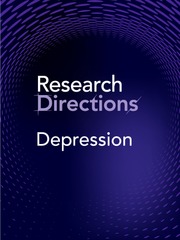Context
One of the most strongly held beliefs in developmental psychiatry is that various emotional, cognitive, behavioural and temperamental factors observed in childhood set the individual trajectory for the risk of onset, course and likely response to treatments in youth and adults with depressive and other mood disorders (Hickie et al., Reference Hickie, Scott, Cross, Iorfino, Davenport, Guastella, Naismith, Carpenter, Rohleder, Crouse, Hermens, Koethe, Markus Leweke, Tickell, Sawrikar and Scott2019).
Various developmental models place emphasis on the salience of internalizing type behavioural patterns (anxious, shy, fearful, socially withdrawn) as well as externalizing patterns (inattentive, oppositional, irritable) observed in pre-pubertal children (Crouse et al., Reference Crouse, LaMonica, Song, Boulton, Rohleder, DeMayo, Wilson, Loblay, Hindmarsh, Stratigos, Krausz, Foo, Teo, Hunter, Guastella, Banati, Troy and Hickie2023). All appear to be associated with increased rates of depressive disorders and (to some degree) other comorbidities (notably substance misuse) or suicidal behaviour as teenagers and young adults. Various of these temperamental paths have been linked specifically with difficulties in the development of normal circadian rhythms (poorly established sleep-wake cycle, feeding and activity patterns), which may mediate the relationships with later mood disorders (Marino et al., Reference Marino, Andrade, Montplaisir, Petit, Touchette, Paradis, Côté, Tremblay, Szatmari and Boivin2022; Tesfaye et al., Reference Tesfaye, Wright, Zaidman-Zait, Bedford, Zwaigenbaum, Kerns, Duku, Mirenda, Bennett, Georgiades, Smith, Vaillancourt, Pickles, Szatmari and Elsabbagh2021).
Other important paths have included significant variations in neurodevelopment (e.g., neurodevelopmentally delayed, neurodivergent, autism spectrum, learning difficulties) (DeMayo et al., Reference DeMayo, Young, Hickie, Song and Guastella2019). For example, there is evidence that people with autism are at higher risk than the general population for depression and suicidal behaviour, especially in females (Lai et al., Reference Lai, Kassee, Besney, Bonato, Hull, Mandy, Szatmari and Ameis2019; Martini et al., Reference Martini, Kuja-Halkola, Butwicka, Du Rietz, D’Onofrio, Happé, Kanina, Larsson, Lundström, Martin, Rosenqvist, Lichtenstein and Taylor2022; Wright et al., Reference Wright, Courchesne, Pickles, Bedford, Duku, Kerns, Bennett, Georgiades, Hill, Richard, Sharp, Smith, Vaillancourt, Zaidman-Zait, Zwaigenbaum, Szatmari and Elsabbagh2023). There is also a literature on the relationship between attentional development (attentional difficulties and overactivity, ADHD) and later depression (Ameis et al., Reference Ameis, Haltigan, Lyon, Sawyer, Mirenda, Kerns, Smith, Vaillancourt, Volden, Waddell, Zwaigenbaum, Bennett, Duku, Elsabbagh, Georgiades, Ungar, Zaidman-Zait, Lai and Szatmari2022). However, the strengths of relationship, and mediating and moderating influences, have not been thoroughly explored.
Various of these paths have been proposed as not only increasing the risk of onset of depressive and other mood disorders in post-pubertal youth but also to the development of specific depressive subtypes (e.g., anxious depression, bipolar and atypical depression, psychotic depression). Further, it has been proposed that this has important implications for differential medical, psychological, or behavioural treatment selection (Hickie et al., Reference Hickie, Scott, Cross, Iorfino, Davenport, Guastella, Naismith, Carpenter, Rohleder, Crouse, Hermens, Koethe, Markus Leweke, Tickell, Sawrikar and Scott2019; Lord et al., Reference Lord, Charman, Havdahl, Carbone, Anagnostou, Boyd, Carr, de Vries, Dissanayake, Divan, Freitag, Gotelli, Kasari, Knapp, Mundy, Plank, Scahill, Servili, Shattuck, Simonoff, Singer, Slonims, Wang, Ysrraelit, Jellett, Pickles, Cusack, Howlin, Szatmari, Holbrook, Toolan and McCauley2022).
The specificity of any of these paths or their actual predictive capacity is challenged by other data that simply note that rates of anxiety are increased in children who go onto develop any of the major anxiety, mood or psychotic disorders as teenagers or young adults (Kessler et al., Reference Kessler, Amminger, Aguilar-Gaxiola, Alonso, Lee and Ustün2007). These data are more consistent with the notion that many observed phenotypes are simply age or developmental-stage dependent. So, anxiety, autism, attentional and impulsive or poorly regulated behaviours are the major phenotypes of childhood, while more complex mood, identity and cognitive phenotypes cannot truly emerge until later ages and stages of brain and social development.
Issues therefore related to the nature of continuity of risk, underlying neurobiological mechanisms and critical developmental transitions (e.g., puberty) across the childhood and youth phases – and how they specifically relate to the age of onset, and phenotypic presentations of major anxiety, depressive and other mood disorders – remain the subject of very active research. The outcomes of this research have important implications for optimal timing and nature of potential prevention strategies (i.e., the value of targeting anxiety in pre-pubertal children; the effects of universal vs selective or indicated prevention), as well as the design and implementation of early interventions, particularly in the immediate post-pubertal period.
How to contribute to this Question
If you believe you can contribute to answering this Question with your research outputs find out how to submit in the Instructions for authors (https://www.cambridge.org/core/journals/research-directions-depression/information/author-instructions/preparing-your-materials). This journal publishes Results, Analyses, Impact papers and additional content such as preprints and “grey literature.” Questions will be closed when the editors agree that enough has been published to answer the Question so before submitting, check if this is still an active Question. If it is closed, another relevant Question may be currently open, so do review all the open Questions in your field. For any further queries check the information pages (https://www.cambridge.org/core/journals/research-directions-depression/information) or contact this email ([email protected]).
Competing interests
IBH is the Co-Director of Health and Policy at the Brain and Mind Centre (BMC) University of Sydney, Australia. The BMC operates an early-intervention youth services at Camperdown under contract to Headspace. Professor Hickie has previously led community-based and pharmaceutical industry-supported (Wyeth, Eli Lily, Servier, Pfizer, AstraZeneca, Janssen Cilag) projects focused on the identification and better management of anxiety and depression. He is the Chief Scientific Advisor to, and a 3.2% equity shareholder in, InnoWell Pty Ltd which aims to transform mental health services through the use of innovative technologies.





